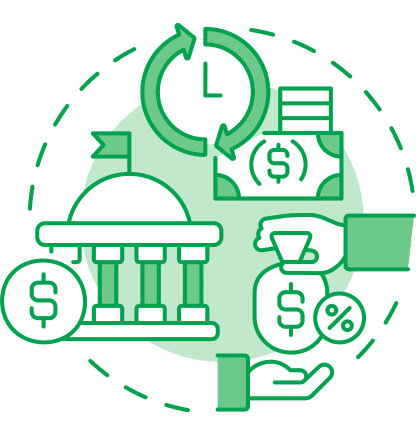How to Pay for College
If you’re planning on pursuing a degree, figuring out how to pay for college is a major obstacle. According to the Education Data Initiative, the full cost of attendance to get a four-year degree averages $103,000 for public in-state schools and $218,000 for private nonprofit schools.
It’s more important than ever for students and families to make careful decisions about paying for college.
Luckily, there are ways to offset your education costs and make it more affordable. Read on to learn about the best way to pay for college and save money.

The Best Way To Pay for College
1. Save for college ahead of time
529 plans
529 plans are the most popular vehicles for saving for college. When you invest your money into a 529 plan, you can take advantage of tax-deferred investment growth and tax-free withdrawals if you use the money for qualified education expenses, including tuition and fees. With a 529 plan, contributions of up to $16,000 per year qualify for the annual gift tax exclusion.
Coverdell Accounts
With a Coverdell Education Savings Account (ESA), you get tax-deferred investment growth and tax-free withdrawals when you use the funds for qualified education expenses. You can contribute up to $2,000 per year to a Coverdell account.
Saving Bonds
Savings bonds are commonly given as gifts for children’s birthdays or milestones, such as graduation. Offering a low level of risk and guaranteed investment growth, they’re considered a safe way to supplement your college savings. And, under certain conditions, interest is excluded from federal income taxes if you redeem the bonds to pay for qualified education expenses.
2. Fill out the FAFSA
Completing your Free Application for Student Aid, or FAFSA, may be the most important step in the process in paying for school. Filling out and completing your FAFSA provides your school with the necessary information to determine how much federal student aid you qualify for along with any financial aid from your state and university. In order to receive federal grants, work-study jobs, federal student loans, and other aid, you first have to fill out your FAFSA each year.
The FAFSA application is relatively long and might take up to an hour to complete. Before you begin, gather the information you will need:
- Your driver’s license and Social Security number
- If applicable, your parents’ Social Security numbers and dates of birth
- Your (and your parents’, if applicable) most recent federal tax return, W-2 forms, and bank statements
- Any records you have for your (and your parents’, if applicable) untaxed income and assets, such as checking and savings accounts, investments and real estate
This information is used for identity verification and helps your school calculate your Expected Family Contribution (EFC). The school’s financial aid office uses your EFC, along with your year in school, enrollment status and the total cost of attendance to decide how much financial aid to provide. In many cases, aid is given on a first-come, first-serve bases, so you should apply as soon as you can.

3. Choose the right school
If you’re wondering how to pay for college without loans, the school you choose can have a significant impact on the cost of your education. According to The College Board, the average cost of a year at a public in-state university is $10,740. By contrast, a year at a private university would cost a staggering $38,070 on average. Opting for a public school over a private one would help you save over $100,000, when you spread the cost out over four years.
However, there are times when choosing a more expensive school makes sense. If the school can offer you more substantial financial aid, it may be more cost-effective to go to a private university than a public one. Each school you apply to will give you a financial aid award letter outlining the details of your financial aid package. It’s important to consider your award letter and the school’s total cost of attendance after deducting the financial aid you’ll receive before making a decision.
4. Apply for scholarships
Scholarships are awarded by schools, organizations, and private companies to students based on merit, such as your academic or athletic performance. They’re a form of free money, meaning that you don’t have to repay them. Scholarships range from $100 to “full rides,” which means the complete cost of your tuition is covered. You can even apply for multiple scholarships and use them to reduce your education costs, helping you save money.
Check with your selected schools to see what scholarships they offer and what the application process is for each. Your school may also participate in the CSS Profile, where you can apply for institutional scholarships. However, your university isn’t the only way to get scholarships. Your high school’s guidance counselor can be a great resource for local and regional options. You can also check out Purefy’s top 50 recommended scholarships.


5. Research potential grants
Like scholarships, grants are a form of free money and don’t need to be repaid. However, grants are typically based on your financial need, rather than your academic or athletic record. There are many forms of grants, but four of the most common are offered by the federal government:
- Pell Grants: Undergraduate students with exceptional financial need can get up to $6,895 per year to pay for school.
- Federal Supplemental Educational Opportunity Grant (FSEOG): Undergraduate students with an exceptional financial need can get up to $4,000 per year to cover additional educational expenses.
- Teacher Education Assistance for College and Higher Education (TEACH) Grant: If you plan on becoming a teacher and attend a TEACH-eligible program, you can get up to $4,000 per year.
- Iraq and Afghanistan Assistance Grant: If your parent or guardian was a member of the U.S. armed forces and died as a result of their military service performed in Iraq or Afghanistan after the events of 9/11, you could be eligible to receive up to $6,895 per year to pay for college.
6. Consider work-study programs
While you’re a student, one option you can use to pay for a portion of your education is to participate in a federal work-study program. With this approach, your school will connect you with a part-time job that’s connected to your field and you may work at a non-profit organization or a public agency. Work study often offers flexibility around your course schedule in a way a typical part-time job cannot. You’ll earn at least minimum wage, but some fields pay more than that.
You can use your earnings to pay for some of your education. By combining work-study with grants and scholarships, you can dramatically reduce your education costs and you may not need to borrow any money at all.
You’ll know from your financial award letter if you qualify, and from there you can contact your school’s financial aid office to make arrangements.

7. Pick up a part-time job
8. Take out federal student loans
Direct Subsidized Loans
Direct Unsubsidized Loans
Parent PLUS Loans
Income-driven Repayment Plan
Loan Deferment and Forbearance
Public Service Loan Forgiveness
To qualify for federal student loans, make sure you submit the FAFSA ahead of its deadline.
9. Apply for private student loans
In some cases, the amount of money you receive in grants, scholarships, and federal loans may not be enough to cover the full cost of your attendance. If that happens, you may be wondering, “How can I pay for college?” In fact, you may need to find additional funding to cover the gap. That’s when private student loans can be an essential resource for paying for college.
Unlike federal student loans, which are offered by the government, private student loans are handled by individual banks or other financial institutions. Interest rates and repayment terms can vary from lender to lender, and they’ll look at your credit score and income to determine whether or not to approve you for a loan and to decide what interest rate you’ll receive. If you don’t have a strong credit history yet (and most students don’t), you will likely need a cosigner to help you qualify.
It’s important to compare rates from multiple private student loan lenders to ensure you get the best rates. But don’t worry about doing it on your own. You can use Purefy’s rate comparison tool to get offers from several lenders at once so you can make an informed decision.

Common Mistakes To Avoid
Payday Loans
Payday loans may seem like a quick and easy way to get cash in hand, but this short-term loan has high costs. Payday loans have fees ranging from $10 to $30 for every $100 borrowed, which is an annual percentage rate (APR) of close to 400%. Federal student loans, by comparison, have an interest rate of 4.99% for undergraduates during the 2022-2023 school year. Repayment for a payday loan is typically due two weeks to a month after the money is received. The repayment often occurs automatically, by either cashing a check left with the lender or debiting the account provided at the time of the loan. Don’t have the money in your account yet? This can lead to more fees with your bank and/or the payday loan lender.
Auto Title Loans
If you own your vehicle, auto title loans may seem like a reasonable option, but they come with many of the same problems payday loans do. APRs are generally very high and you will not have much time to pay back the loan.
With auto title loans, you also must put up ownership of your automobile as collateral for the loan. What this means is that, should you be unable to pay back the loan, ownership of your car will transfer to the lender.
This would not only a be a huge financial loss, but it might also prevent you from being able to drive to work or school, further complicating your ability to pursue your degree.
Credit Cards
It may seem easy to cover your tuition with a credit card, but credit cards often have a much higher APR than what student loans can offer. Credit card interest rates can approach or even exceed 20%, while Federal student loan rates for undergrads are currently at 4.99% as of August 2022.
Additionally, many schools charge processing fees for using a credit card, and credit cards do not have the same borrower protections and repayment plans as student loans.
Conclusion
If you’re struggling to figure out how to pay for college, it’s important to remember that there are several options available to you. By combining different strategies, you can lower your education costs and reduce how much money you need to borrow with student loans.
Remember to fill out your FAFSA as early as you can and look to your school’s financial aid department for help and support along the way. Offsetting your education costs and making college more affordable is possible.
And if you do need a private student loan to pay for college, make sure you shop around to get the best deal before applying. Purefy has made this easy with our rate comparison tool, which compares multiple lenders and helps you find your best rate in minutes, with no fees and no impact on your credit.

Go In-Depth with Purefy's Expert Guides
Planning for College Costs
Essential Financial Aid Information
Federal Student Loans
Private Student Loans
Graduate & Professional Student Loans
College Life & Money Management
Want more content handpicked by our student loan experts, and delivered straight to you?
How to Pay for College - FAQ
Before you consider taking out student loans for college, you should first pursue grants and scholarships. Both can help you pay for college, and neither require that you pay any money back. Grants are generally awarded based on need, whereas scholarships are often based on merit (think academics or athletic ability). Grants and scholarships can be awarded by the federal government, your state, your school, or even a private organization or individual.
Not everyone has college savings to help fund their education. If you don’t have much savings — whether it be your own savings or your parents — you still have options. Beyond grants and scholarships, you could also consider doing a federal work-study program, or even taking on a part-time job while you study at college. If that’s not enough, you may need to consider applying for student loans.
Whether or not you need federal student loans, you should fill out the FAFSA each year. It’s what the government uses to determine your federal student aid package — including grants and work-study. If you’ve maxed out your federal student loan options, private student loans may be the best choice. To get the best deal, you can compare top lenders in Purefy’s rate comparison tool, and once you select a lender, you will be taken to their website to apply.
A full ride scholarship is one that covers the entire cost of attending college. The reality is, that even if you have a great SAT score and GPA, these types of scholarships are hard to come by. In fact, only 1.5% of bachelors degree students get enough scholarships and grants to cover the full cost of attendance. The number of students who got enough scholarship and grant money to cover 50% of the cost of attendance is still only 19%.
For 2018–2019, the average tuition and fees for in-state students at public four-year schools was $10,230. For out-of-state students, the average was $26,290. If you’re going to a private non-profit four year school, the average jumps up to $35,830. As you can see, school choice makes a big difference in the cost of your education. Choosing a private college over an in-state college could cost you more than three times as much money.
If you’re an out-of-state student hoping to get in-state tuition, the chances are slim, but it’s possible. In general, if you can attend a high-quality in-state school in your home state, that will be your best bet — but it won’t work for everyone. That said, the rules for getting in-state tuition vary by state and school. Some states have agreements with nearby states to allow in-state tuition reciprocity, especially if you live near the state line. Other schools or states may allow you to establish residency and reduce your tuition after your first year (this is tougher for dependent students whose families will stay in their home state). Check the rules and don’t be afraid to ask your potential new school — you may be surprised.


















